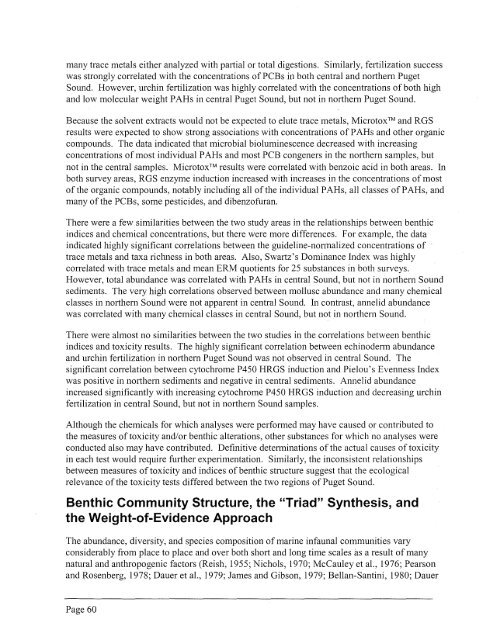Sediment Quality in Puget Sound Year 2 - Center for Coastal ...
Sediment Quality in Puget Sound Year 2 - Center for Coastal ...
Sediment Quality in Puget Sound Year 2 - Center for Coastal ...
Create successful ePaper yourself
Turn your PDF publications into a flip-book with our unique Google optimized e-Paper software.
many trace metals either analyzed with partial or total digestions. Similarly, fertilization success<br />
was strongly correlated with the concentrations of PCBs <strong>in</strong> both central and northern <strong>Puget</strong><br />
<strong>Sound</strong>. However, urch<strong>in</strong> fertilization was highly correlated with the concentrations of both high<br />
and low molecular weight PAHs <strong>in</strong> central <strong>Puget</strong> <strong>Sound</strong>, but not <strong>in</strong> northern <strong>Puget</strong> <strong>Sound</strong>.<br />
Because the solvent extracts would not be expected to elute trace metals, MicrotoxTM and RGS<br />
results were expected to show strong associations with concentrations of PAHs and other organic<br />
compounds. The data <strong>in</strong>dicated that microbial biolum<strong>in</strong>escence decreased with <strong>in</strong>creas<strong>in</strong>g<br />
concentrations of most <strong>in</strong>dividual PAHs and most PCB congeners <strong>in</strong> the northern samples, but<br />
not <strong>in</strong> the central samples. MicrotoxTM results were correlated with benzoic acid <strong>in</strong> both areas. In<br />
both survey areas, RGS enzyme <strong>in</strong>duction <strong>in</strong>creased with <strong>in</strong>creases <strong>in</strong> the concentrations of most<br />
of the organic compounds, notably <strong>in</strong>clud<strong>in</strong>g all of the <strong>in</strong>dividual PAHs, all classes of PAHs, and<br />
many of the PCBs, some pesticides, and dibenzofuran.<br />
There were a few similarities between the two study areas <strong>in</strong> the relationships between benthic<br />
<strong>in</strong>dices and chemical concentrations, but there were more differences. For example, the data<br />
<strong>in</strong>dicated highly significant correlations between the guidel<strong>in</strong>e-normalized concentrations of<br />
trace metals and taxa richness <strong>in</strong> both areas. Also, Swartz's Dom<strong>in</strong>ance Index was highly<br />
correlated with trace metals and mean ERM quotients <strong>for</strong> 25 substances <strong>in</strong> both surveys.<br />
However, total abundance was correlated with PAHs <strong>in</strong> central <strong>Sound</strong>, but not <strong>in</strong> northern <strong>Sound</strong><br />
sediments. The very high correlations observed between mollusc abundance and many chemical<br />
classes <strong>in</strong> northern <strong>Sound</strong> were not apparent <strong>in</strong> central <strong>Sound</strong>. In contrast, annelid abundance<br />
was correlated with many chemical classes <strong>in</strong> central <strong>Sound</strong>, but not <strong>in</strong> northern <strong>Sound</strong>.<br />
There were almost no similarities between the two studies <strong>in</strong> the correlations between benthic<br />
<strong>in</strong>dices and toxicity results. The highly significant correlation between ech<strong>in</strong>oderm abundance<br />
and urch<strong>in</strong> fertilization <strong>in</strong> northern <strong>Puget</strong> <strong>Sound</strong> was not observed <strong>in</strong> central <strong>Sound</strong>. The<br />
significant correlation between cytochrome P450 HRGS <strong>in</strong>duction and Pielou's Evenness Index<br />
was positive <strong>in</strong> northern sediments and negative <strong>in</strong> central sediments. Annelid abundance<br />
<strong>in</strong>creased significantly with <strong>in</strong>creas<strong>in</strong>g cytochrome P450 HRGS <strong>in</strong>duction and decreas<strong>in</strong>g urch<strong>in</strong><br />
fertilization <strong>in</strong> central <strong>Sound</strong>, but not <strong>in</strong> northern <strong>Sound</strong> samples.<br />
Although the chemicals <strong>for</strong> which analyses were per<strong>for</strong>med may have caused or contributed to<br />
the measures of toxicity and/or benthic alterations, other substances <strong>for</strong> which no analyses were<br />
conducted also may have contributed. Def<strong>in</strong>itive determ<strong>in</strong>ations of the actual causes of toxicity<br />
<strong>in</strong> each test would require further experimentation. Similarly, the <strong>in</strong>consistent relationships<br />
between measures of toxicity and <strong>in</strong>dices of benthic structure suggest that the ecological<br />
relevance of the toxicity tests differed between the two regions of <strong>Puget</strong> <strong>Sound</strong>.<br />
Benthic Community Structure, the "Triad" Synthesis, and<br />
the Weight-of-Evidence Approach<br />
The abundance, diversity, and species composition of mar<strong>in</strong>e <strong>in</strong>faunal communities vary<br />
considerably from place to place and over both short and long time scales as a result of many<br />
natural and anthropogenic factors (Reish, 1955; Nichols, 1970; McCauley et al., 1976; Pearson<br />
and Rosenberg, 1978; Dauer et al., 1979; James and Gibson, 1979; Bellan-Sant<strong>in</strong>i, 1980; Dauer<br />
Page 60







